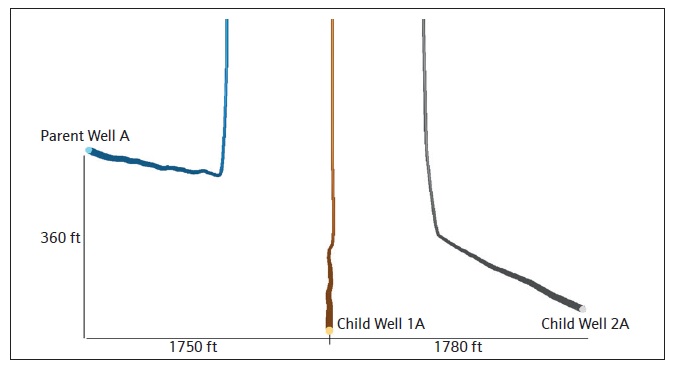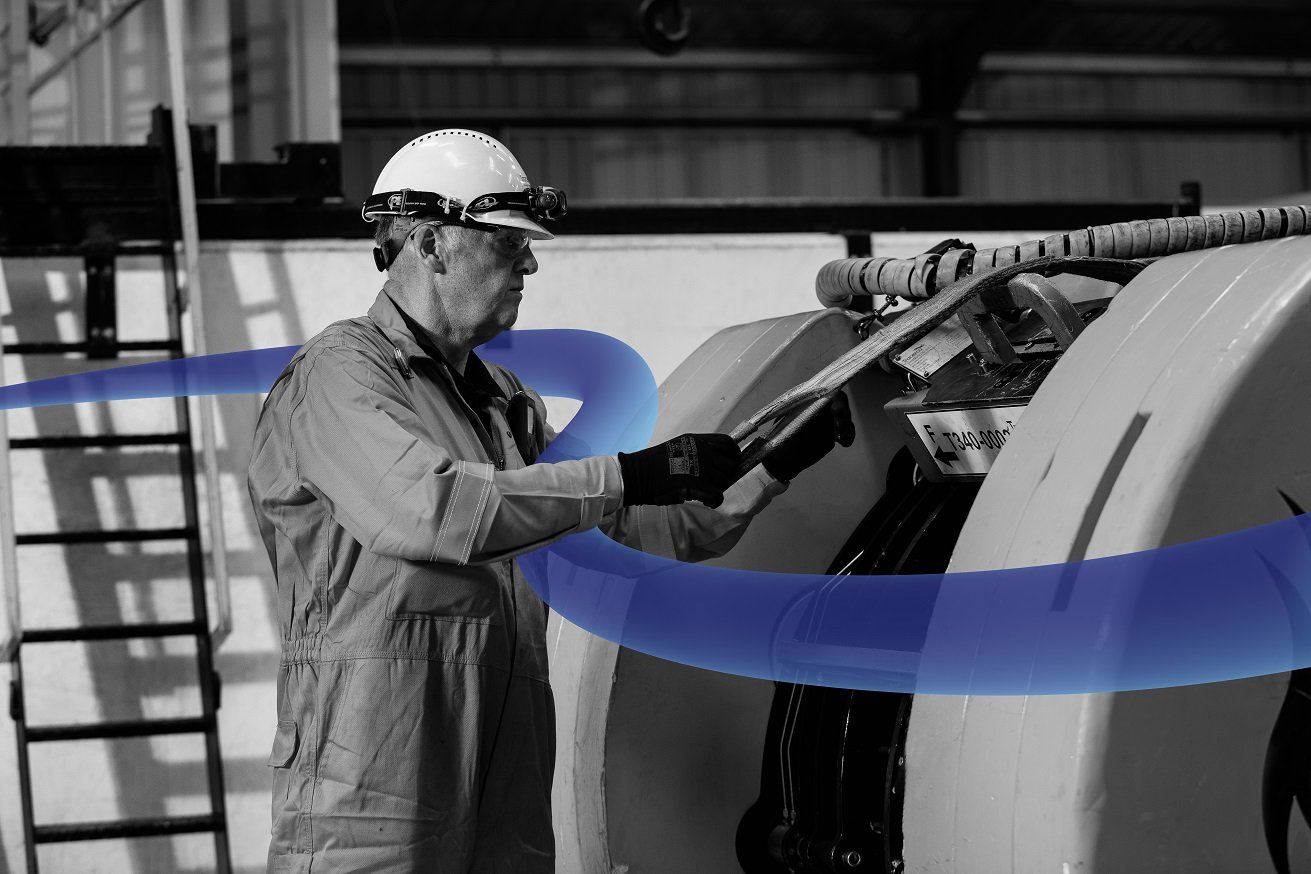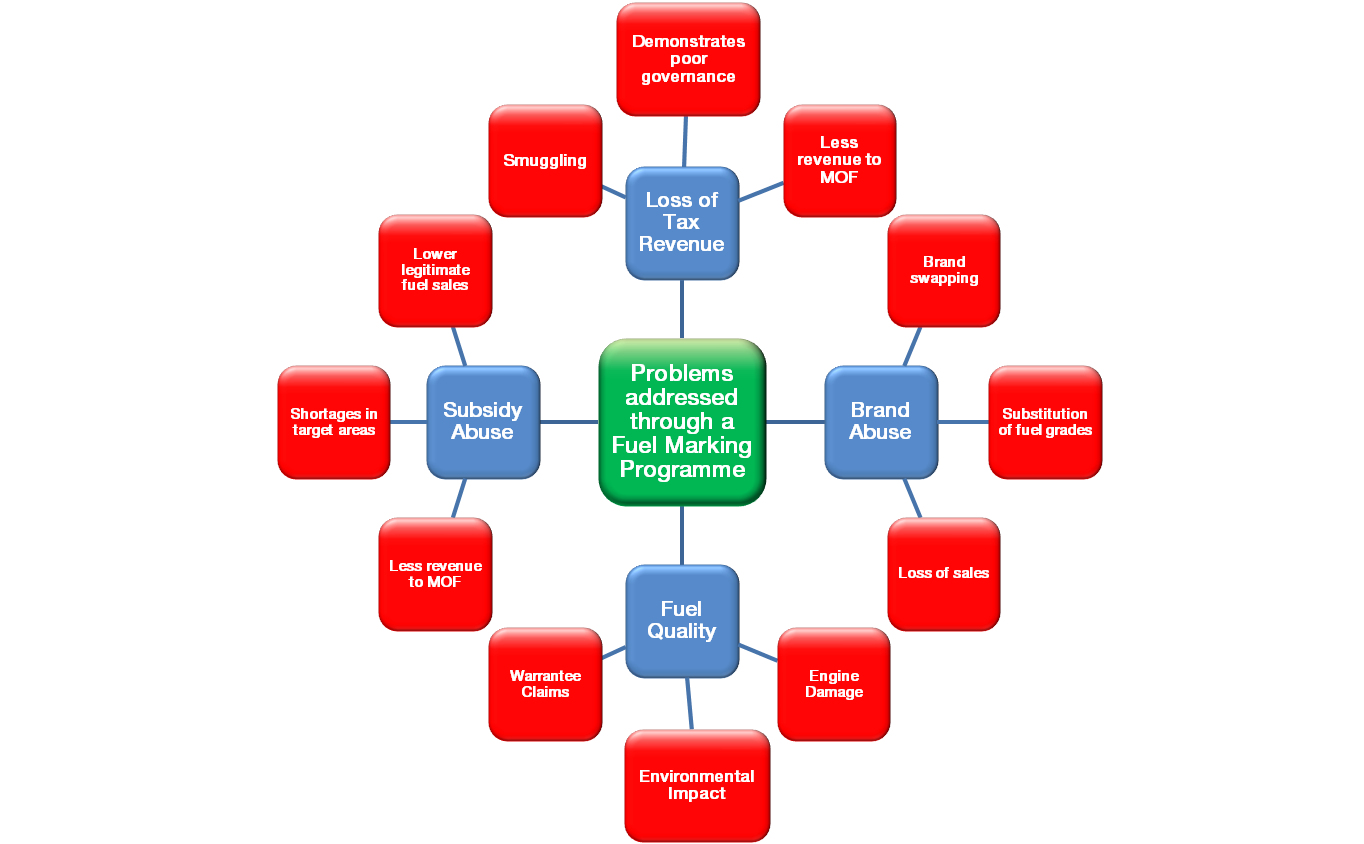Baseline scans of a vessel are undertaken when it is known to be clean, operating normally, and in good mechanical condition. They are often used for comparison purposes on future troubleshooting scans. Any anomaly, or abnormal absorption observed on a baseline scan, that cannot be explained by a visible external interference or by something indicated in the column drawings, may be able to be eliminated as a potential problem area in future troubleshooting scans.
Baseline scanning is critical to diagnose future column problems
Posted by Nicola Porter
Jan 18, 2021 8:49:22 AM
Topics: distillation column, Distillation Column Performance, Column Performance, distillation column maintenance, gamma scanning distillation columns, distillation column scan, distillation column scanning, baseline scan, column troubleshooting
Monitor parent-child well communication using chemical tracers
Posted by Tracerco
Jan 7, 2021 3:14:34 PM
Interactions between fractures in adjacent horizontal wells and development of methods for mitigating their costly negative effects has become the focus of much discussion within the industry. Operators are now acutely aware that one of the key challenges of infill development is avoiding interwell communication between Parent and newly drilled and fractured infill wells.
Topics: chemical tracers, reservoir, reservoir characterisation, fracture diagnostics, well communication
At Tracerco, we recognise that our people are our business and represent the future of our business.
Safety is one of the core foundations we value the most. Tracerco and its employees partnered with businesses and charitable organisations in its local communities for its annual safety stand-down day in December 2019. During the event, we focussed on a range of safety issues, from the more common concerns such as slips, trips and falls, to protecting the environment and how personal wellness and mental well- being can have an impact on safety.
In this blog, we will highlight and discuss our top tips for hosting a successful safety stand-down in the workplace.
Topics: safety, safety stand-down, education, health and safety, safety awareness, EHS culture, safety education, people, EHS, safety culture, mental wellbeing, workplace safety, work safe home safe, safety behaviour, EHS behaviour, employees
Counter fuel laundering and fuel adulteration using non launderable markers
Posted by Nicola Porter
Nov 20, 2019 1:02:48 PM
Fuel laundering, fuel adulteration and fuel smuggling combine to create a global problem for governments around the world. Not only does it deprive them of hundreds of millions of dollars of taxation revenues, it poses a burden to the environment and also to innocent motorists whose vehicles incur long-lasting damage. The cost in terms of policing, dismantling discovered plants, clean-up operations and the safe disposal of dumped toxic sludge — a by-product from such illegal operations — is also considerable.
Topics: authentication, consumer protection, product quality, revenue protection, fiscal tax recovery, adulterated fuel, brand security, counterfeit detection, product protection, product authentication, fuel fraud, brand protection technology, brand authentication, brand protection, safeguard brand quality
How to fight fuel corruption with the implementation of a fuel marking programme
Posted by Tracerco
Nov 20, 2019 9:22:32 AM
In many parts of the world, corruption is common and a part of everyday life. Apart from the corrosive effect this has on quality of service and availability of appropriate justice, this also has a negative effect on commerce. Reputable companies and people are unable to compete, so the market is left to others who are willing to ignore laws put in place to prevent corruption. Where this occurs, the economy suffers due to lack of investment which eventually contributes to poverty, pollution and poor health for the majority of the people who do not profit from corrupt activities. This is the type of environment where fuel fraud can flourish. In this latest blog, Tracerco will discuss how the implementation of a fuel marking program can help in the fight against fuel corruption
Topics: consumer protection, product quality, revenue protection, fiscal tax recovery, safeguard brand equity, adulterated fuel, brand security, counterfeit detection, authentication, product authentication, fuel fraud, brand protection technology, brand authentication, brand protection, counterfeiting, safeguard brand quality, brand, fuel marking, fuel marker, fuel marker technology, fuel adulteration, fuel smuggling, counterfeit fuel
Subsea Pipeline Inspection: Three reasons why Discovery is used to assess asset integrity
Posted by Tracerco
Apr 1, 2019 2:25:05 PM
Maintaining the integrity of subsea pipelines is essential for all oil and gas operators for a variety of reasons. This includes but is not limited to; ensuring the safety of offshore operations, limiting the risk of environmental damage, legally complying with strict regulations, and maximising production via operational efficiencies / extending asset life. DiscoveryTM, the world’s only field proven subsea CT scanner, is a non-intrusive inspection instrument that enables offshore operators to quickly identify pipeline integrity flaws and obtain accurate wall thickness measurements without stopping or interrupting normal pipeline operations. In this blog, we will discuss three reasons why DiscoveryTM is used by operators across the globe to ensure the integrity of their assets and learn the ins and outs of subsea pipeline inspection.
Topics: Discovery, pipeline integrity, Asset Integrity, Subsea Technologies, subsea pipelines, Subsea, Subsea Inspection, Subsea Integrity
Are you attending the 2019 AIChE Spring Meeting in New Orleans April 1- 4th?
Tracerco will be highlighting case studies on how gamma scans were used to monitor fouling accumulation in packed towers at this year's AIChE 2019 Spring Meeting in New Orleans, LA.
Mark your schedule to sit in on the paper "Utilizing Gamma Scans To Monitor Fouling Accumulation in Packed Towers" presented by William Mixon - Market Manager - Process Diagnostics, Baton Rouge, LA and Lowell Pless - Consultant for Tracerco. The presentation will provide actual case studies to illustrate how gamma scanning can be a very cost-effective way to monitor the rate of fouling accumulation and to aid in the planning of turnarounds.'
Read more to find out about all the presentation dates and times Tracerco will be presenting this year.
Topics: Downstream, fouling deposits, Tru-Grid Scan, gamma scanning distillation columns, tower gamma scan, packed bed towers, packed bed performance analytics, trayed tower, manage turnaround costs, Depropanizer scan tray damage, turnaround critical path project, debutanizer, fouling accumulation
Tracerco technology provides our customers a "look" inside their process in real time.
A Tracerco Diagnostics™ Separator study complements other diagnostic tools and techniques available to production engineers. The technology is non-intrusive with preliminary results generated on-site. This allows a rapid understanding of fluid flow and mechanical integrity within a hydrocarbon separation train by essentially making the process transparent. This approach significantly eliminates guess work when trying to resolve process issues and allows accurate process data to be gathered providing information so that engineering decisions on process improvement or repair can be quickly made and implemented. If deemed necessary, immediate changes to a system can be made with further measurements to assess if improvements have resulted.
Read more and watch a short animated video to learn how Tracerco's tracer and scan investigations can help optimize separator performance.
Topics: Upstream, Separator, Damage to vessel internals, separator study, oil in water, Blockages in perforated plates, Flow distribution
Optimizing Desalter Performance is Just One of Tracerco's Specialties We Proudly Provide.
Desalter vessels are a refinery’s first line of defense to reduce the amount of unwanted salts present in the feed inventory. Prior to crude oil entering a refinery processing stream it undergoes a water washing stage where the water used during this process is separated using Desalter vessels. In these vessels the oil and water mixture separate from each other using gravity and high voltage coalescing plates. The water phase contains the washed salts as well as other suspended solids. Desalting and separation prevents water and salts from entering the crude unit furnaces, distillation towers and other downstream equipment. Salts, sediment, and other solids will foul the process and can undergo chemical change to produce corrosive chemicals that cause damage to process metallurgy. It is therefore important to efficiently separate wastewater from crude feedstock within the Desalter vessels.
Tracerco Tru-Scan™ technology provides you detailed data on where the oil/water interface level is, determines if there is a significant “rag” or emulsion layer or detects how many solids are built up in the bottom of the Desalter. In addition to performing these applications our advanced tracer studies are used to provide residence times of the oil and water phases and distribution within the vessel. Further to our scanning and tracer technologies that can aid plant personnel in optimizing your process, our award winning Tracerco Profiler™ HTX instrument provides accurate phase measurement including oil, emulsion (rag), water and solids/sludge in real time. The installation of the Tracerco Profiler™ HTX can eliminate unplanned Desalter shutdowns, reduce chemical usage, increase fluid throughput and provide the capability to handle more challenging crude blends.
Read more to learn how Tracerco helped our customer determine what was actually happening within their Desalter.
Topics: desalting, Flow distribution, desalter optimization, desalter, desalter maldistribution, distribution study
Tracerco Insight Vol. 8 Ed. 2 newsletter is now available.
The Tracerco Insight newsletter featuring some of our latest case studies illustrating how Tracerco was able to provide our customers the necessary data that allowed the operations staff to make informed decisions for troubleshooting and optimising their process. Read more to see what's inside the latest issue.
- Optimizing Desalter Performance Is Just One of Tracerco's Specialties We Proudly Provide.
- Crude Vacuum Tower Wash Bed Optimization.
- Application Note - ThruVision™
- Manage and Control Your Turnaround Costs to Avoid Possible Surprises.
- New Product Announcement: PED-ER and PED-ER+
Read more on how to download the latest issue.
Topics: nucleonic instrumentation, Tru-Scan, process diagnostics technologies, gamma scan, monitor wash bed coking, tracer technology, Tracer Study, catalyst bed wash, desalter optimization, wash bed optimization, manage turnaround costs, Depropanizer scan tray damage, desalter, Tracerco Profiler, crude vacuum tower, turnaround critical path project, pre-turnaround scans
Oil and Gas Comment and News
Tracerco's news and comment on measurement and diagnostics in Oil & Gas and processing industries
Tracerco brings comment, news, how tos and more on their blog. Sign up for regular notifications of new posts.
Subscribe to Email Updates
Recent Posts
Posts by Topic
- reservoir (18)
- reservoir characterisation (17)
- Gamma Scanning (16)
- chemical tracers (16)
- Flow assurance (15)
- Tru-Scan (15)
- gamma scan (15)
- people (15)
- pipeline inspection (15)
- Discovery (14)
- Process Diagnostics (14)
- employee recognition (14)
- pipeline integrity (14)
- tracers (14)
- Life at Tracerco (13)
- Subsea Technology (13)
- Working Lives (12)
- subsea flowlines (12)
- Colleague Forum (11)
- subsea pipelines (9)
- Asset Integrity (8)
- Explorer (8)
- Subsea Inspection (8)
- Subsea Integrity (8)
- Tru-Grid Scan (8)
- liquid distribution (8)
- nucleonic instrumentation (8)
- Awards (7)
- PackView Analysis (7)
- fluid inflow (7)
- optimising plant processing (7)
- packed bed towers (7)
- quantitative analysis pack beds (7)
- reservoir analysis (7)
- unconventional wells (7)
- Distillation Column Performance (6)
- Liquid maldistribution (6)
- Process Diagnostics Technology (6)
- Suspected maldistribution in packed beds (6)
- desalter optimization (6)
- excessive flare flow (6)
- flare system tracers (6)
- fracking (6)
- interwell (6)
- packed column (6)
- pipe in pipe (6)
- pipeline blockage (6)
- pipeline life extension (6)
- process diagnostics technologies (6)
- tracer technology (6)
- CT scanner (5)
- Separator (5)
- Subsea flexibles (5)
- Tracer Study (5)
- Tracerco Profiler (5)
- Tracerco innovations (5)
- distillation column maintenance (5)
- gamma scanning distillation columns (5)
- inflow measurement (5)
- packed bed performance analytics (5)
- packed bed scan (5)
- pipe bundles (5)
- pipeline extension (5)
- plant processing (5)
- radiation monitor (5)
- smart tracers (5)
- tracerco diagnostics (5)
- tray fouling (5)
- water inflow (5)
- CT scanning (4)
- NORM (4)
- NORM Management (4)
- Subsea Technologies (4)
- chemical leak test (4)
- chemical tracer technology (4)
- density of liquid (4)
- fcc diagnostics (4)
- fcc troubleshooting (4)
- fcc unit process (4)
- fccu studies (4)
- feed/effluent heat exchangers (4)
- fluid catalytic cracking unit (4)
- fugitive flare flow (4)
- gulf of mexico (4)
- hydrocarbon separation train (4)
- instrumentation (4)
- instrumentation control (4)
- multiphase separation (4)
- north sea (4)
- nucleonic instrument (4)
- oil inflow (4)
- online leak detection (4)
- process control (4)
- radiation (4)
- scanning technology (4)
- tower gamma scan (4)
- tower scanning (4)
- trayed tower (4)
- unconventional oil and gas (4)
- water production (4)
- Column Performance (3)
- Decommissioning (3)
- Downstream (3)
- Flow Study (3)
- Flowlines (3)
- FrothView (3)
- NORM Detection (3)
- Naturally Occurring Radioactive Material (3)
- Packed Beds (3)
- Radiation Protection (3)
- Radiation Protection Adviser (3)
- Tray Damage (3)
- adulterated fuel (3)
- brand authentication (3)
- brand protection (3)
- brand security (3)
- catalyst bed wash (3)
- consumer protection (3)
- controlled release (3)
- counterfeit detection (3)
- delayed coke drum (3)
- desalting (3)
- distillation column (3)
- distillation column scan (3)
- distillation column scanning (3)
- distillation tower scanning (3)
- enhanced interface control (3)
- exchanger bundle leak testing (3)
- fcc cracking (3)
- fcc services (3)
- fcc unit (3)
- fiscal tax recovery (3)
- flare flow (3)
- flare gas flow measurement (3)
- flare gas flow meter (3)
- flare study (3)
- fluid catalytic cracking diagnostics (3)
- fluid catalytic cracking services (3)
- frac wells (3)
- gamma ray inspection (3)
- gas processing (3)
- increase production rates (3)
- increased separator efficiencies (3)
- inflow (3)
- injected water (3)
- leak detection (3)
- leak tests (3)
- manage turnaround costs (3)
- mature offshore field (3)
- monitor wash bed coking (3)
- neutron backscatter (3)
- nucleonic technology (3)
- off spec product (3)
- oil & gas (3)
- oil processing (3)
- optimising oil and gas production (3)
- optimising plant production (3)
- packed column performance (3)
- packing mal-distribution (3)
- ped (3)
- personal electronic dosimeter (3)
- process condition monitoring (3)
- process systems (3)
- product quality (3)
- profiler (3)
- radiation detection (3)
- radiation safety (3)
- revenue protection (3)
- separator performance (3)
- technology enabling cost savings (3)
- tomography scan (3)
- tower scan (3)
- trayed columns (3)
- turnaround critical path project (3)
- turnaround planning (3)
- turnaround schedules (3)
- turnarounds (3)
- verify flow meters (3)
- water breakthrough (3)
- waterflood (3)
- waterflood injection (3)
- well development (3)
- wellbore (3)
- Catalytic cracking (2)
- Damage to vessel internals (2)
- Depropanizer scan tray damage (2)
- Engineering (2)
- Events (2)
- Flooded Memeber Inspection (2)
- Flow distribution (2)
- High temperature plant processing (2)
- Houston events (2)
- INWED22 (2)
- Imagine the Future (2)
- International Women in Engineering Day (2)
- Inventors and Innovators (2)
- Level+ (2)
- Maths (2)
- PhaseFinder (2)
- Radiation Waste Adviser (2)
- SAGD (2)
- SRU Unit (2)
- STEM (2)
- Science (2)
- Subsea (2)
- Sulphur Recovery Unit (2)
- TENORM (2)
- Technology (2)
- ThruVision scan (2)
- Tracerco technologies (2)
- Tray Capacity (2)
- Upstream (2)
- Women in STEM (2)
- Women in engineering (2)
- annular liquid distribution (2)
- area monitoring (2)
- authentication (2)
- baseline scan (2)
- brand protection technology (2)
- coke (2)
- coke buildup (2)
- coke deposits (2)
- coke drum (2)
- coke drum cycle (2)
- coke drum optimization (2)
- coker optimization (2)
- column troubleshooting (2)
- counterfeiting (2)
- cracking unit (2)
- desalter (2)
- dose rate (2)
- dosimeter (2)
- drilling (2)
- employees (2)
- exchanger (2)
- fcc (2)
- fcc process (2)
- fcc riser (2)
- fcc units (2)
- fccu process (2)
- fccu unit refinery (2)
- fixed monitoring (2)
- flare flow measurement (2)
- flare flow meter (2)
- flare flowrate data (2)
- flare gas meter (2)
- flare gas meters (2)
- flare lines (2)
- flare measurement (2)
- flooded trays (2)
- flow profiling (2)
- flow rate calculations (2)
- flowrate (2)
- fouling (2)
- fouling deposits (2)
- fuel fraud (2)
- gas flow meter proving (2)
- gas meter proving techniques (2)
- inflow tracer (2)
- insights (2)
- leaking exchangers (2)
- level detection devices (2)
- liquid restriction (2)
- marketing (2)
- mechanical integrity (2)
- monitoring (2)
- monitors (2)
- observa (2)
- oil in water (2)
- oil production (2)
- pigging (2)
- pre-turnaround scans (2)
- process diagnostics systems (2)
- process equipment (2)
- process vessels (2)
- product authentication (2)
- product protection (2)
- reservoir production modeling (2)
- residual oil saturation (2)
- safeguard brand equity (2)
- safeguard brand quality (2)
- safety (2)
- safety awareness (2)
- safety stand-down (2)
- separator study (2)
- shale (2)
- shale production (2)
- small leaks (2)
- solids buildup (2)
- stuck pig (2)
- tracer analysis (2)
- water tracer (2)
- well communication (2)
- work safe home safe (2)
- workplace safety (2)
- Ammonia converter (1)
- Be Safe (1)
- Blockages in perforated plates (1)
- CCS (1)
- CCUS (1)
- CDU (1)
- Carbon capture and storage (1)
- Carryover (1)
- Column Flooding (1)
- Demulsifier Chemical (1)
- Digital Marketing (1)
- EHS (1)
- EHS behaviour (1)
- EHS culture (1)
- EPD (1)
- Entrainment (1)
- FCCU (1)
- FMD (1)
- FMI (1)
- Global exchange (1)
- H2S Absorber (1)
- Heavy oil (1)
- InDepth (1)
- Intercat (1)
- Life cycle management (1)
- NORM Monitor-IS (1)
- NORM Survey Meters (1)
- OTC (1)
- PSV (1)
- Physics (1)
- Platform Members (1)
- Platform Memeber Integrity (1)
- Platform Structural Members (1)
- SEO (1)
- Suspected maldistribution (1)
- ThruVision (1)
- Tracerco Day (1)
- Tray weeping (1)
- Water Ingress (1)
- Weeping (1)
- activities (1)
- adulteration (1)
- authentication solutions (1)
- authentication, product authentication (1)
- beer column (1)
- brand (1)
- brand protection tehnology (1)
- butadiene condenser (1)
- butadiene purification unit (1)
- calibrate flow meters (1)
- catalyst loss (1)
- celebration (1)
- coker units (1)
- counterfeit fuel (1)
- critical path (1)
- critical path planning (1)
- crude distillation unit (1)
- crude unit (1)
- crude vacuum tower (1)
- debutanizer (1)
- desalter maldistribution (1)
- desalter performance (1)
- distillation column service (1)
- distillation tower scan (1)
- distribution study (1)
- education (1)
- electronic personal dosimeter (1)
- environmental reporting (1)
- exchangers (1)
- extraction tower (1)
- fcc addition systems (1)
- fcc additives (1)
- fcc reactor (1)
- flare gas measurement (1)
- foam profile (1)
- fouled trays (1)
- fouling accumulation (1)
- fracture diagnostics (1)
- fuel adulteration (1)
- fuel marker (1)
- fuel marker technology (1)
- fuel marking (1)
- fuel smuggling (1)
- fugitive emissions (1)
- gamma ray inspection distillation (1)
- gamma scan distillationcolumns (1)
- gammatrac (1)
- gas flow meter prover (1)
- gas plant (1)
- gas undercutting (1)
- grout monitoring (1)
- health and safety (1)
- heat exchanger (1)
- heat exchangers (1)
- interface levels (1)
- leak study (1)
- leak testing (1)
- leaking pressure safety valve (1)
- leaking psv (1)
- liquid carry-over (1)
- liquid liquid extractor (1)
- marker systems (1)
- mass transfer diagnostics (1)
- medical (1)
- mental wellbeing (1)
- mobile tracer labs (1)
- new technology (1)
- oil residence time test (1)
- outdoor fun (1)
- personal dosimetry (1)
- pig run (1)
- pig tracking (1)
- pig tracking services (1)
- plant performance (1)
- polymer tracer technology (1)
- polymerisation (1)
- popcorn polymer (1)
- pre-turnaround planning (1)
- pressure safety valve (1)
- process optimisation (1)
- process pipes (1)
- product assurance (1)
- providing insight onsite (1)
- radioactive source security (1)
- radiography (1)
- reactor cyclone (1)
- reactor distributor (1)
- reactor riser (1)
- reactor stripper (1)
- real-time insights (1)
- real-time measurement (1)
- refining (1)
- refractory depth (1)
- refractory lined pipes (1)
- refractory lined vessels (1)
- refractory loss (1)
- refractory measurements (1)
- regenerator cyclone (1)
- remaining oil saturation (1)
- reservoir fluid inflow (1)
- reservoir stimulation (1)
- responsive design (1)
- riser reactor (1)
- risers (1)
- safety behaviour (1)
- safety culture (1)
- safety education (1)
- separation tower scanning (1)
- separator systems (1)
- shutdown planning (1)
- shutdowns (1)
- source security (1)
- source theft (1)
- tower performance (1)
- trayed extraction tower (1)
- wash bed optimization (1)








